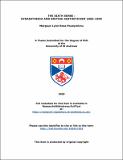The sixth sense : synaesthesia and British aestheticism, 1860-1900
Abstract
“The Sixth Sense: Synaesthesia and British Aestheticism 1860-1900” is an
interdisciplinary examination of the emergence of synaesthesia conceptually and
rhetorically within the ‘art for art’s sake’ movement in mid-to-late Victorian Britain.
Chapter One investigates Swinburne’s focal role as both theorist and literary spokesman
for the nascent British Aesthetic movement. I argue that Swinburne was the first to
practice what Pater meant by ‘aesthetic criticism’ and that synaesthesia played a decisive
role in ‘Aestheticising’ critical discourse.
Chapter Two examines Whistler’s varied motivations for using synaesthetic metaphor,
the way that synaesthesia informed his identity as an aesthete, and the way that critical
reactions to his work played a formative role in linking synaesthesia with Aestheticism in
the popular imagination of Victorian England.
Chapter Three explores Pater’s methods and style as an ‘aesthetic critic.’ Even more than
Swinburne, Pater blurred the distinction between criticism and creation. I use
‘synaesthesia’ to contextualise Pater’s theory of “Anders-streben” and to further
contribute to our understanding of his infamous musical paradigm as a linguistic ideal,
which governed his own approach to critical language.
Chapter Four considers Wilde’s decadent redevelopment of synaesthetic metaphor. I use
‘synaesthesia’ to locate Wilde’s style and theory of style within the context of decadence;
or, to put it another way, to locate decadence within the context of Wilde.
Each chapter examines the highly nuanced claim that art should exist for its own sake and
the ways in which artists in the mid-to-late Victorian period attempted to realise this
desire on theoretical and rhetorical levels.
Type
Thesis, PhD Doctor of Philosophy
Collections
Items in the St Andrews Research Repository are protected by copyright, with all rights reserved, unless otherwise indicated.

